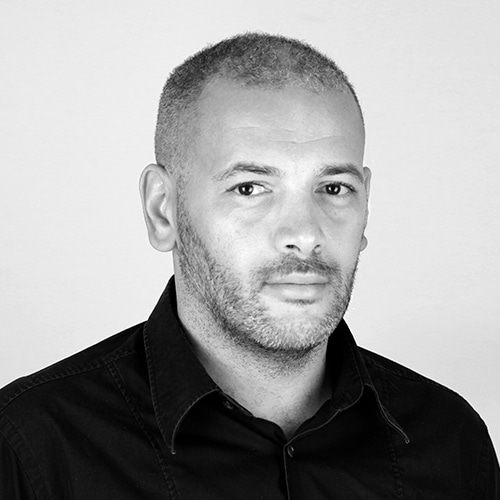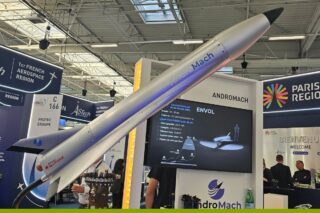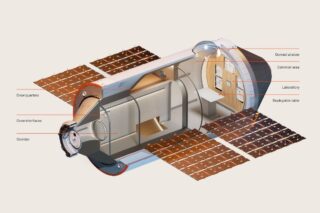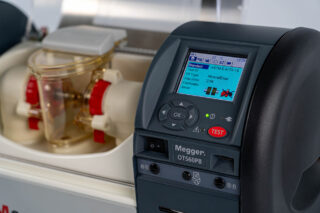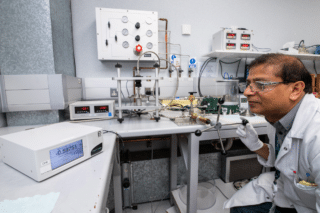Axians assists its clients in the evolution of their infrastructures and digital solutions, particularly in the deployment of 5G. However, it is evident that in the industry, many stakeholders are still unaware of all the benefits of a 5G network. We interviewed Sébastien Becquet, Business Manager at Axians at the Global Industrie trade fair. He shared his insights with us.
Do you think some industrial players haven’t fully grasped the advantages of 5G yet?
Sébastien Becquet: “The advantages of 5G, how it is architected, and what it is used for. Today, when you talk about 5G to certain industrialists, they don’t know what it represents in terms of architecture: is it servers? Is it radio sites? How does it transmit? How do you deploy it? Then, there is the question of the usage and the technological advantage in terms of latency, handover, and coverage areas. It’s still very unclear for some of them, even though we can sense that industrial players have started to show interest. We observe inquiries, with business leaders expressing, “Alright, I’ve heard about this technology, but what benefits does it offer me?” So, they start doing some research, looking at who can provide this service, and examining what other industrial players have accomplished. This level of inquiry hasn’t been common until now. So, we’re seeing a growing democratization of this knowledge, even though it hasn’t yet reached a majority. So, we need to educate them and show them that it’s not that complicated and that it’s quite easy to deploy.”
If it’s easy to deploy, what is needed then?
Sébastien Becquet: “We need to start with the infrastructure part with a core network. A core network consists of servers and virtual machines inside. Normally, industrial players understand this and some even already have it as they already have IT departments. It’s even possible to interface with the client’s existing infrastructure. Then, there are radio sites and identifying emission points. The idea is to place these radio sites to cover the entire factory.”
And who decides where to place radio sites? You?
Sébastien Becquet: “Exactly. Our job is to do the radio engineering for our clients based on the KPIs they have requested. This includes choosing the number of antennas, and their positions. It also means determining the coverage area, whether it is outdoor or indoor if there has to be continuity everywhere or just in a specific zone.”
Do your clients conduct a study beforehand to know the ROI they can achieve?
Sébastien Becquet: “Some industrial players are already in this process. They know their weaknesses and are in the process of optimizing. Therefore, they’re looking at which technology can meet their needs and optimization. Others may be more in the discovery phase of the 5G technology and ask questions about what it is used for, and what its advantages are. And then it’s up to us to say which are these advantages and the ROI they can achieve.”

Can you share with us a concrete example of a deployment you have carried out?
Sébastien Becquet: “We carried out a deployment project for the Port of Bordeaux in France. Previously, to move a container, the agents would go to the central building to retrieve paper orders, and then go to the straddle carrier to move the containers. They acknowledged that the current solution wasn’t effective and expressed the need for Wi-Fi. However, Wi-Fi failed to deliver satisfactory coverage due to various reasons. First, there is interference caused by the metallic containers. Wifi also necessitates the deployment of numerous access points, resulting in a complex setup. As for us, we proposed an alternative technology: private 4G. They inquired about the rationale and implementation, to which we explained that we could blanket the entire port with a single radio site, enabling them to digitalize their operations.”
What was the customer feedback then?
Sébastien Becquet: “They have an ROI within six months on the installation, they reimbursed the installation costs. Now, we’ve transitioned from a primarily process-oriented approach to one where we’re building upon existing frameworks. They’re now considering how private 4G can enhance their operations, particularly in terms of field personnel geolocation. This entails sending alerts based on the positions of individuals moving around the port, such as when a forklift truck approaches within five meters, prompting a cautionary alert. Similarly, for drivers, warnings can be issued regarding pedestrians in the vicinity. This additional layer of personal safety further expands the range of potential applications we can support.”
Does the transition from 4G to 5G simply involve changing antennas?
Sébastien Becquet: “Indeed, there are two possibilities. ARCEP has opened up bands in both 4G and 5G, known as band 38. It would simply be a software upgrade within the core network. If you want to move into the second band that is open, which is currently an experimental band, known as band 77, then you need to change the emission points. Because a radio site emitting in band 38 may not necessarily emit in band 77. So, you can upgrade the core, but you will need to change the radio infrastructure.”
What is the most challenging aspect for you when deploying a 5G network?
Sébastien Becquet: “In the industry, generally speaking, coverage isn’t the biggest difficulty. What challenges us is how to interconnect different systems. The goal of 5G networks is to collect data. And so, when you collect data, different automated systems and protocols are speaking. Being able to aggregate all this data and make it available to our clients, that’s what can be a little bit complicated.
The second major challenge is cybersecurity and more generally, connecting to existing networks. The IT department generally comes into play, they’ll look at what we’re going to do and then say, be careful, in my systems, I want completely separate flows. So, it’s going to be network engineering in the IT sense and the cyber layers we can add. It’s also a real challenge for us. In this case, it’s not just industrial, it’s much more general.”
Is exposure to waves a challenge?
Sébastien Becquet: “Yes, this exposure to waves is an important issue. For safety, it’s really about proving to our clients that there is no health risk when deploying 5G networks. It’s a real topic that is also somewhat social for them. We must accompany our clients to reassure them and show them that everything is going well. And generally, it’s accompanied by certifying bodies specialized in this field.
Then there’s also change management. Today, it’s about showing that in an industry where people are used to communicating only with large terminals, we can centralize everything on a smartphone. This changes ergonomics. So, we need to accompany our clients in this change management part. And that’s a real challenge for us as well as for them.”
Do you use digital simulation tools to simulate waves?
Sébastien Becquet: “Yes, absolutely. We use tools for indoor and outdoor radio simulation. For outdoors, we import precise maps up to five meters, for example, in lateral distance as well as height. So, we can do simulations, place points with a given height, set emission powers, and create coverage maps. And then we check what we call RSSI RSRP levels and also throughput levels. When clients tell us they want at least ten megabits of throughput at every point of their coverage, we can verify those kinds of things. For indoor, we implement plans and conduct 3D indoor coverage simulations. We have the necessary tools at our disposal to do these things. But my colleagues in the field will tell you that it’s a great starting point, but nothing beats a real-world test.”
And what’s the real-world test?
Sébastien Becquet: “We bring in a standalone site and position our radio sites where we have theoretically predisposed them. We then verify that everything is okay.”
In which industrial sector do you primarily deploy?
Sébastien Becquet: “In logistics, there’s a real need due to process automation, robotics, etc. We also feel that there’s a real need in ports and airports. With today’s connected airports, the goal is to minimize the time aircraft spend on the ground. So, the more automation you have and the faster information circulates between different stakeholders, the greater the ROI.”
What about the automotive sector?
Sébastien Becquet: “To be quite honest, so far we haven’t seen much activity from the automotive sector. However, we are currently involved in a project called Géo 5G as part of the France Relance initiative, aimed at Stellantis. They aim to utilize 5G for pinpointing the location of tooling to within approximately one meter. The idea, on production lines, is to automatically adjust torque settings based on the operator’s position. For instance, when using a screwdriver, the torque is adjusted according to the operator’s location, varying between “I’m here” and “I’m there,” with the torque automatically adapting accordingly.”
Is it possible to achieve such precise geolocation?
Sébastien Becquet: “The Germans have done it, but it requires a lot more infrastructure. Essentially, you need many more radio sites to geolocate yourself in space in the best way possible. So, the costs are not the same. But again, everything is calculable.”

